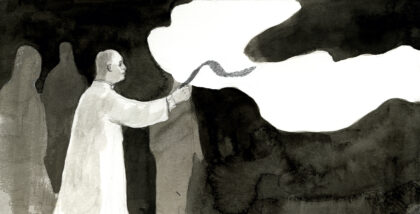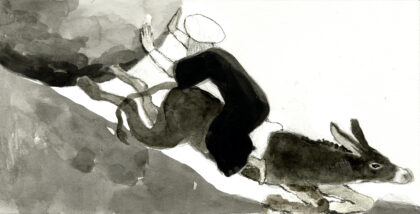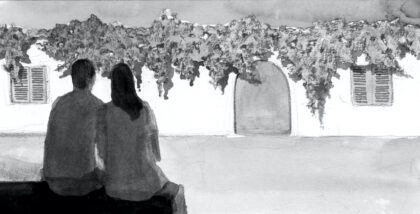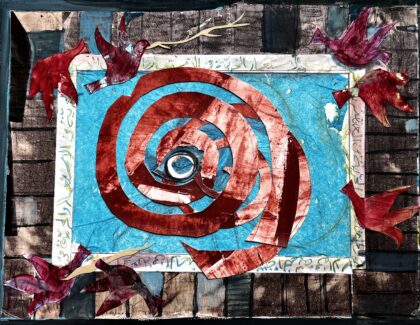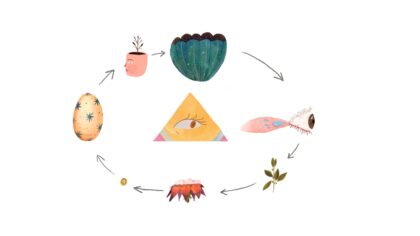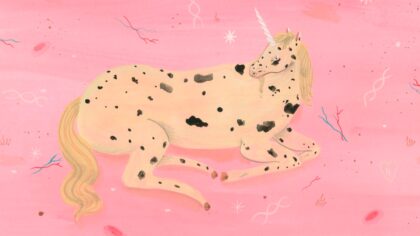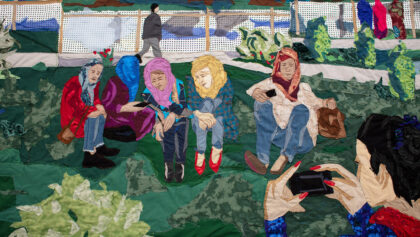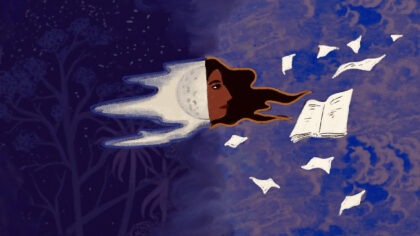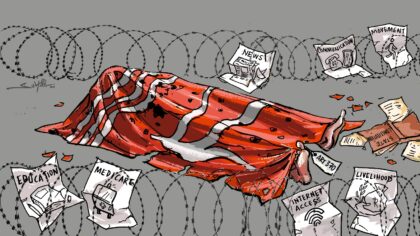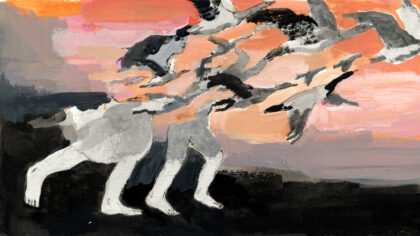 Art by Jia Sung
Art by Jia Sung
I tend to scoff at signs, but when it turned out our grandfathers—his abuelito, my abbajee—were both mango farmers, in Mexico and Pakistan, respectively—literal opposite ends of the world—I became, temporarily, a believer. It was on our second date, I think. New York winter: outside, snowfall; inside, hot drinks and giddy serendipity. So many things had to happen, or not happen, for our paths to cross this way. He grew up in rural Jalisco and California; I was a Karachi girl through and through—una florecita del asfalto, an asphalt flower, you might say. We didn’t know where we’d end up, or whether we’d end up there together. And yet. The table where we sat, sticky with coffee rings, was mez in Urdu, mesa in Spanish. It felt like a private miracle.
Love has a way of ensconcing even the most curmudgeonly, but escaping the outside world was difficult that year. Trump floated down escalators, railing against bad Mexican hombres, slapping blanket bans on Muslim visitors. “Do you feel safe here?” white American friends would ask. “We’re so sorry,” they’d say—well-intentioned, I’m sure, but it always rubbed me the wrong way. Our romance was a source of great delight and, I think, solace. “You are literally Trump’s worst nightmare!” they’d exult, and we’d smile sweetly—a happy anomaly, a two-headed mascot for multiculturalism against a backdrop of bubbling hate. Unease puckered inside me each time; I could never quite articulate why.
If, in New York, we were a triumph of the possibilities of America, elsewhere we inhabited a different story, one just as marked with America’s imprint. “Terrorism?” murmured his mother, when he told her he intended to marry a Pakistani woman. “Cartels…” whispered my father when he found out I’d be traveling to Mexico. You couldn’t really fault this word association; everything they knew about each other’s countries was filtered through the gaze of a third.
So, instead, we brandished the mango: how it made its way to the West—it travelled east, actually, from Manila to Acapulco on Spanish galleons in the eighteenth century, where it was exchanged for silver. When he came to Pakistan, my family, pouncing upon this connective thread, paraded every possible local variety before him. They’re better than yours, right, they asked brightly, while I cringed in a corner. It’s a much-derided trope in South Asian literature: the mango as a symbol of immigrant angst, Eastern exotica. Truth be told, I didn’t want to invoke it here at all. But this is an essay about a different sort of longing.
*
People living somewhere on the margins of the West, writes Jamaican poet Kei Miller, often become blessed with a kind of double vision. You see your life from the inside, and also from the outside—both locally and globally. You are conscious always of the reality of what you are living, and also the strange narrative of it. You become conscious of how this might be observed.
I stumbled upon the Miller quote in Samia Khatun’s Australianama, an excavation of encounters between South Asian and Aboriginal peoples under the shadow of the British Empire. The book begins in a moment of crisis: at a hospital in Sydney, Khatun’s mother Eshrat, undergoing surgery for ovarian cancer, has visions of a melting Qur’an that she narrates only to her daughter in Bengali; when she talks to doctors in English, everything is perfectly okay. She is convinced, she tells Khatun, that her roommate, a soldier back from Afghanistan and haunted by the place, is trying to murder her in her sleep. Eshrat and her melting Qur’an cannot be imprisoned overnight with the soldier killing Afghans at the battlefront, Khatun begs the doctors and nurses. But no one at the hospital can understand why.
Immigration assumes—on occasion, demands—political severance from the homeland; there is expectation of a new allegiance, scrubbed clean of previous attachments.
Immigration assumes—on occasion, demands—political severance from the homeland; there is expectation of a new allegiance, scrubbed clean of previous attachments. Khatun, a second-generation immigrant in Australia, begins to question this. “On a cloudless afternoon, as the jacarandas shed purple refuse over the footpath that I treaded with my mother,” she writes, “it suddenly became clear: Western states cannot bomb, exploit, drone, invade and kill South Asians and have us as part of their citizenry at the same time.”
It’s not a clean analogy but, reading Khatun, I began to understand my own unease in New York. I wasn’t an immigrant in the US—I was a student on a State Department scholarship, part of a longstanding “peacebuilding” program whose largest beneficiaries are currently Afghanistan and Pakistan—yet frequently found myself fending off assumptions that I wanted to be one. An immigrant, that is. After all, as Khatun notes, this was what the script of progress dictated: from East to West, from the Third World to the First, Aboriginal country to settler nation. I resented being yanked into this narrative, hated having a linear, triumphal trajectory imposed over the scatter of my life—it made me overly, unnecessarily defensive. You see your life from the inside, and also from the outside. You become conscious of how it might be observed.
In Australianama, as the tale of multicultural kumbaya buckles and collapses around her in a hospital garden in Sydney, Khatun begins searching for alternatives too. A historian by training, she looks to the past; a blurry image in an old history book catches her eye. It appears to be a nineteenth-century Bengali translation of the Qur’an. What was it doing, she wonders, in an inland Australian mining town, and who brought it there? This question awakens her to other histories. Beginning in the mid-eighteenth century, South Asians—cameleers, lascars, merchants, saints, wives, runaways, indentured laborers—arrived on the land that is now Australia; as they moved through the arteries of empire, their lives intertwined with Aboriginal lives. What were these encounters like? Perhaps these exchanges—between non-white peoples on Anglo-imperial terrains—might offer a different story to inhabit, a different future to look toward.
*
The word archive has its roots in arkheion—Greek, Jacques Derrida tells us in Archive Fever, for “house of the ruler.” The arkheion was the residence of the superior magistrates, archons; it was here that official documents were stored, preserved, and interpreted. The archive, in other words, is historically bound to power. “The concept of the archive shelters in itself, of course, this memory,” writes Derrida. “But it also shelters itself from this memory which it shelters: which comes down to saying also that it forgets it.” This isn’t an accident: as Michel-Rolph Trouillot notes in Silencing the Past, the ultimate mark of power is its invisibility; the ultimate challenge, the exposition of its roots.
The archive forgets. It also misremembers. At the edge of the desert, by a rocky hill polished black by winds, on the country of the Wiljakali people, in the land that is currently Australia, stands a little red mosque. It was built in 1887. On a shelf inside, among letters, a peacock feather fan, and perfume from Delhi, lies a large book with a handwritten English label: The Holy Koran. Except it wasn’t a Qur’an. It was a book of Bengali Sufi poetry, published in nineteenth-century Calcutta.
The archive ignores. In Australianama, as Khatun searches for traces of the person who carried the book of Bengali poetry across the Indian Ocean, she encounters numerous non-English-language accounts of these encounters, systematically ignored by Australian historians. A seafarer’s travelogue narrated in Urdu in Lahore. Aboriginal oral histories told in Kuyani, Arabunna, Wangkangurru, and Dhirari. Ahmadi prophecies. Urdu, Persian, and Arabic dream texts. Why are these sources consistently omitted from the historical record? The inattention stems from an underlying assumption, Khatun postulates, that texts in non-European languages do not change the larger thrust of history.
The archive shrinks. In 1965, Lyndon B. Johnson signed into law the Hart–Celler Act, upending longstanding racist US immigration policies designed to maintain the demographic status quo, a move that opened the doors of the US to tens of thousands of skilled professionals from across the world, including the Indian subcontinent. “These are the South Asian immigrants Americans would come to know in the 1970s, 1980s and the 1990s: the doctors, the engineers, the entrepreneurs,” writes Vivek Bald in Bengali Harlem—a narrative so entrenched, so determined to prove the worthiness of the people at its center and their right to belong, that it has obscured earlier immigrant histories. From the late nineteenth century all the way up to the middle of the twentieth, for instance, Indian peddlers and seamen jumped ship and married Puerto Rican and Black women. “Denied official belonging, they became part of another nation, a nation beneath the nation, in working class neighborhoods of color from New York to Baltimore to Detroit.” Meanwhile, on the other side of the country, Punjabi farmers married Mexican women and settled along the southern and western borders of the US.
Many of these early South Asians, Bald writes, “left no obvious archives, no clear public record, and no single place to mark their presence. In their own day, many intended to ‘disappear’—at least, to the authorities of a nation that would not legally admit them.” In other words, they did not—could not —build toward a future that would remember them.
Trouillot again: The past does not exist independently from the present. The past is only past because there is a present, just as I can point to something over there only because I am here. The past—or more accurately, pastness—is a position.
*
I moved to Mexico City two years ago and felt, immediately, both homesick and at home. Creep of bougainvillea on the walls, glut of cars on the streets. Our neighborhood awoke to the blare of se compran colchones; my drowsy ears mistook it for the raddi-wala’s cry back home. The city had an effect on me akin to the uncanny valley—Karachi, if it wore its hair differently. As a reporter and writer, this made me wary. I was loathe to trust my own instincts, worried I would mistake shallow familiarity for understanding. I felt self-conscious, too: I’d seethed at too many foreign journalists parachuting into Pakistan to subject Mexico to my own outsider’s gaze. Mostly, though, I didn’t want to report from Mexico for an American audience—I wanted to reach Pakistan without refracting stories through a Western lens.
I wanted both my cities to huddle together and compare notes: plot against technocratic notions of modernity, security, livability.
Mexico City incited a deep longing in me for a Karachi that didn’t exist but could, theoretically: matriarchs selling snacks on the streets, plazas teeming with lovers, music in the air. I wanted both my cities to huddle together and compare notes: plot against technocratic notions of modernity, security, livability. Realizing how very little is directly exchanged within the Global South, I felt unexpectedly bereft. (This is what I’m calling homesickness—I have no other word for it.)
Hoping to chip away at this sense of loss, I began reading about the Punjabi farmers who married Mexican women in the early twentieth century. They aren’t entirely lost to history—there’s a book about them from 1992, considered definitive, by American historian and anthropologist Karen Leonard. I dislike it very much. I suppose it’s a product of its time, but I hate its cold remove, its treatment of its subjects as historical anomalies, its reliance on the county archives to tell stories about marriages and dissolutions, arrests and lawsuits.
Still, I scraped from it what I could:
Sucha Singh Garewal, a leading Holtville farmer, removed his sweaty socks only to expose brightly painted red toenails, compliments of his Mexican niece. He had been napping with his shoes and socks off earlier that day and she had adorned his toes.
Puna Singh spoke of his first impressions: “On arriving in the Sacramento Valley, one could not help but be reminded of the Punjab. Fertile fields stretched across the flat valley to the foothills lying far in the distance.”
One woman told of her husband-to-be cavorting on his horse in the row ahead of her as she picked cotton, while his partner dropped a gaily colored handkerchief over her sister’s hair.
There is one poignant story of Nand Kaur at a Utah trading post…She saw other women, “tall and colored like us,” with long black braids and “I felt like going over to them and hugging them.” But her husband told her they were American Indians. She went over to listen to them. He was right, they were not speaking Punjabi.
*
Four years ago, during a road trip across the US, we stopped by the old gurdwara at Stockton, just south of Sacramento. Built by a wealthy potato farmer, Jawala Singh, it is the oldest house of Sikh worship in the country; I wanted to visit because it also houses a century-old printing press, which rolled out the first pages of the anti-imperial Ghadar newspaper. Surrounded by bouquets of dusty felt flowers, the clunky cast-iron contraption had pride of place in the large hall. But we were quickly distracted by the photos on the walls: the stern and smiling faces of our Punjabi-Mexican forebears.
On winter nights, before Mexico City bloomed purple with jacarandas and masks began blotting out faces everywhere, we regaled friends with these histories, joked about how a shared love of corn—makai ki roti in Punjab, maize tortillas across Mexico—may have fueled these romances. We marveled collectively at their familiar, foreign names: Maria Jesusita Singh, Jose Akbar Khan, Armando Chand, one Ganga Ram baptized as Arturo Gangara. Are these stories mine to tell, I’d find myself wondering sometimes, looking at my Mexican friends, or are they yours? I worry about reducing these lives to cocktail chatter—historical fun facts stripped of context, accent-lit museum artifacts.
The power in these encounters lies, I think, in the knowledge systems brought close, exchanged, and possibly transformed as a result. (These encounters are not always equal or equally recorded: while South Asians feature in many Aboriginal recollections, for instance, the reverse is not the case.) Still, as Khatun writes, in the words, books, stories, dreams and songs that still reside in us, that we bring with us to our encounters with another person, another people, may lie strategies for resisting and surviving modern regimes of power. What might these strategies be, exactly? I can’t tell you: as someone educated almost entirely in English—in a colonial-era school that still imports a headmaster from England, and at universities in London and New York—I’m constantly trying to stamp out the little European man strutting about in my head. “It is ironic,” writes Mughal historian Taymiya Zaman, “that many of us must travel through Western academia, read texts that have been turned into artifacts and their life-worlds into objects of study, only to come back to a living, breathing tradition that should have been part of our own life-worlds to begin with.” This, I suppose, is another form of homesickness.
I have a new story I’m waiting to tell our friends when we next gather, about the extraordinary life of Aziz Balouch, who moved from Sindh to Gibraltar in 1932. Every other night, Balouch would slip over into a Spanish border town to listen to flamenco, in which he immediately recognized the Sufi mystical tradition from back home. This story comes with a soundtrack: an EP recorded by Balouch in 1962 was rediscovered and re-released last year. You can listen to his soaring, stirring vocals—in Persian, then Spanish—against the ripple of a flamenco guitar here. In the photos of him that survive, he wears a pinstriped suit and a karakul cap, and he cradles a Spanish guitar. No archive might ever confirm this link between the two traditions—although it is now a point of scholarly debate—but nearly a hundred years ago, Balouch felt it in his bones.
I feel it too. There are ways of knowing that exist beyond the constitutive limits of the archive. When I think of these encounters on the margins of the West, under its shadow, I sense something else, too—possibility, and power. On particularly wearisome days—and there are so many now, as the world continues to lurch rightward—I think of Nand Kaur’s thrill at the sight of those tall, black-braided fellow travelers. I think of Sucha “El Loco” Singh wiggling his red toenails in the Imperial Valley sun. Like a talisman, I hold these images close.
